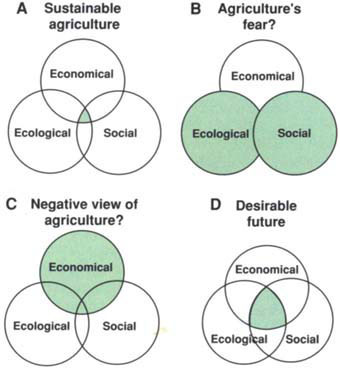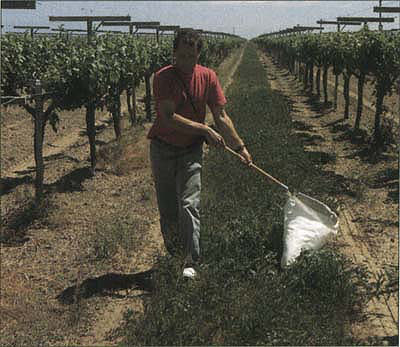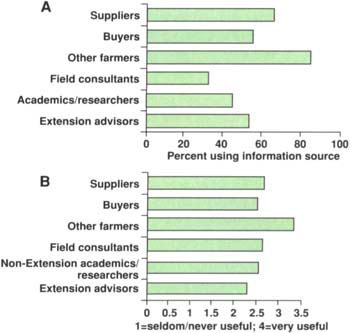All Issues
Farming in transition Overview: Society pressures farmers to adopt more sustainable systems
Publication Information
California Agriculture 48(5):7-10.
Published September 01, 1994
PDF | Citation | Permissions
Abstract
Pressures ranging from government regulation of air, water and food to the often unsympathetic views of an urban populace have put increasing demands on farmers to adopt more sustainable practices. Yet there is no set formula for doing so; the best way to achieve sustainability varies according to region and climate, and in many cases is still under study. UC scientists and farmers are working in partnerships across the state to learn which farming systems are most successful and economically viable.
Full text
In response to society's demands for more ecologically sound and socially acceptable practices, farmers and ranchers today are attempting to meet environmental, social and economic goals simultaneously — in an effort that is often termed “sustainable agriculture.”
Nearly every action taken by a farmer or researcher is aimed at meeting one of these goals. But we no longer have the option of achieving one goal at the expense of the others. As difficult as it may be, we must now achieve all three at the same time (fig. 1).
Site-specific journey
Ultimately, each farmer must devise the appropriate system for his or her farm based on personal goals, local conditions, published research and on-farm experimentation. The transition “to what, from what” is a site-specific, individual journey. For example, cover cropping is often a first step because it can enhance both soil quality and habitat for pest management, but no single strategy or practice is applicable in all cases.
In soil and pest management, it is widely recognized that detrimental effects on air quality, surface water and groundwater must be minimized. Substituting biologically based approaches — such as planting nitrogen-fixing legumes, enhancing habitats for beneficial insects, managing soil to enhance microbial activity and rotating crops to avoid or reduce pest problems — for some applications of synthetic materials may achieve this goal.
Nearly all farmers and ranchers practice some of these strategies. While consensus is building around farmers' and society's joint interest in protecting environmental quality, the social concerns of sustainability are viewed by many as more difficult to address. Issues of rural community stability, loss of farmland, labor conditions, consumer nutrition and agricultural policy touch very deep concerns about individual and societal values and threaten to divide farmers and other groups in society. However, progress can be made by identifying achievements by innovative farmers and community groups. For example, UCCE County Director Gary Johnston and colleagues interviewed farmers about their methods of extending the employment season for farm labor. (Results are scheduled for publication in the January-February 1995 issue of California Agriculture.)
Fig. 1. Schematic diagram of various views of agriculture, represented by shaded areas. Sustainable agriculture is the intersection of economically sound, ecologically viable, and socially responsible approaches (A); some agriculturists fear that they will be forced to achieve environmental and social goals at the expense of economics (B); a negative perception of agriculture views it as achieving economic goals at the expense of environment and society (C); a desirable future would include expansion of the area that achieves all three goals through improved research and practical experience (D).
Often environmental and social goals are well beyond the farmer's sphere of control. Land use decisions, air and water quality, and labor conditions are affected by everyone, city dwellers as well as farmers. Farmers and ranchers need the cooperation of urban and rural residents to achieve these goals. However, a lack of understanding and communication between farmers and the rest of society often hinders this cooperation. Community supported agriculture (see box, p. 8) is one way in which consumers can share in the experience of farming and expand their understanding of agriculture. Farmers' markets are used by large farmers, as well as small ones, to keep in touch with consumer trends. Advertising and point-of-purchase information (signs and brochures in retail stores, for example) may facilitate communication when producers and consumers are distant from one another. Groups that bring together farmers, environmentalists, policy makers, business interests and other community members to share concerns and perspectives can lead to strategies that are best suited to the particular community. An example of such a group is the Ventura County Food Safety Study Group, which UC SAREP helped sponsor through a grant in 1990 to UCCE County Director Larry Yee and UC Berkeley economist Tim Wallace.
Old and new research
The UC research and extension community is promoting sustainability through a variety of old and new research methods. Virtually every issue of California Agriculture in recent years has presented research that addresses some component of sustainability, from biological approaches to pest management to new varieties of legumes for pasture improvement or crop rotation.
Many special programs at UC address sustainability issues (e.g., the Agricultural Issues Center, the Kearney Foundation for Soil Science, the Small Farm Program and many more) as do the research programs of most departments, field stations and commodity programs. Most commodity groups sponsor research into IPM, biological control, varietal improvement and other components of sustainability.
Researchers are increasingly being asked to study these components in the context of whole systems. UC's 15-year-old statewide Integrated Pest Management Project (UC IPM) has fostered many such efforts, including the McKellar citrus project, decision-support systems such as the Calex cotton model and practical programs and manuals on integrated pest management (see California Agriculture, September-October 1990). More recently, the boundaries of the systems under study have been broadened beyond pest management, and experimental designs have moved toward whole systems as the units of treatment, as in the UC Davis cropping systems experiments described in this issue ( see p. 14 ).
Innovative farmers are an excellent source of ideas for the best practices and systems to include in these experiments. UC SAREP funds studies under the category “monitoring innovative producers” to identify and systematically describe some of these farming systems. These inexpensive studies often lack replication and other characteristics of traditional scientific methods, but they efficiently identify promising systems and components for further, replicated study. Furthermore, innovative scientific methods of analysis, such as geostatistics (a branch of analysis that describes patterns in the landscape), can be applied to these monitoring approaches to increase their scientific validity. Case studies are another valuable form of “whole system” description, which is particularly useful to investigate social phenomena where traditional experimentation is impossible or unethical.
Wine grapes have led the way in pesticide reduction. Growers using IPM on California wine grapes have cut their insecticide and fungicide use by half.
Funding for research in sustainable agriculture has grown considerably in recent years. UC's statewide Sustainable Agriculture Research and Education Program (UC SAREP) has funded more than $2 million in research and education projects since its inception in 1986, and the budget of its federal counterpart, the U.S. Department of Agriculture's Sustainable Agriculture Research and Education (SARE) program, has grown from less than $4 million in 1988 to more than $7 million in 1994. In general, research funds from both UC and commodity groups are increasingly being directed toward biological control, soil improvement and other more sustainable practices. Private foundations are also redirecting funds, most notably the $4.5 million program of the Northwest Area Foundation, and more recently the W.K. Kellogg Foundation's $18 million Integrated Farming Systems program of community-based demonstration projects. The Organic Farming Research Foundation, founded in 1989, has awarded approximately $145,000 in grants for 1990 through 1993.
Adoption and extension
Because sustainable agricultural practices are so ubiquitous, and sustainable agricultural systems are so site-specific and individualized, it is difficult to answer the question: how widespread is their adoption? Related concepts such as organic farming and integrated pest management are more narrowly defined and thus more easily measurable. Membership in California Certified Organic Farmers has grown from 54 growers and 3,469 acres in 1973 to 488 growers and 49,121 acres at the end of 1993. Wine grapes and cotton are two areas of greatest growth in organic production. Although CCOF is a major program, not all organic growers are members. However, they all must register with the state of California. California Department of Food and Agriculture estimates that there are currently more than 1,400 organic growers in the state; up from approximately 840 growers 4 years ago. Roughly one-third are in San Diego County, and Sonoma and Mendocino counties have more than 100 each.
Considerable information exists to show that the adoption of integrated pest management systems in California has been successful in many crops. For example, one study found that 9 of 16 IPM practices were used by more than 65% of the state's almond growers in 1985 (see California Agriculture, September-October 1990). The Senate Agriculture Committee recently reported that California growers using IPM on wine grapes have cut their insecticide and fungicide use by at least 50%.
When UC applied behavioral scientist Jim Grieshop and research assistant Arnaz Raj asked farmers attending selected conferences in 1990 to rate themselves on a scale from “highly ecological” to “highly conventional,” they showed a pronounced trend toward ecological in the past 5 years and predicted further movement in the next 5 years. Those who used more of such practices as crop rotation, intercropping, cover crops, compost, release of beneficial predators, pest resistant varieties, drip irrigation, direct marketing, and specialty crops and markets rated themselves as more ecological than did growers who used fewer of those practices. Virtually all growers used some of the “more sustainable” practices (see California Agriculture, March-April 1992). Similar trends appeared in surveys conducted at meetings sponsored by UC SAREP in 1992 and 1993. Of course, farmers who completed these surveys at SAREP meetings are not a random sample of the state's farmers. They are probably more representative of some of the “early adopters” in the transition.
Growers also rely on their own in-field observations and trials. Farmer organizations help facilitate farmer-led research and sharing of information. Examples include commodity groups, such as the Lodi-Woodbridge Wine Grape Commission, and cross-commodity groups, such as the California Clean Growers Association, the Lighthouse Farm network, and the Organic Farming Research Foundation (OFRF). A national survey of certified organic farmers conducted by OFRF showed that other farmers are the most frequently used (fig. 2A) and highly valued (fig. 2B) of all personal contacts. The same pattern is true for California organic farmers in this survey.
The increasing visibility and relevance of farmer and citizen groups has caused some to question whether the role of the university, and particularly of Cooperative Extension, is changing. In 1993 two workshops were held on education and information dissemination at the national SARE-sponsored conference, “Science and Sustainability.” Participants in both workshops identified the changing role of extension from “top-down source of information” to “horizontal facilitator of information exchange” as one of three top priorities for discussion. Maintaining scientific credibility is a key concern of many who are considering taking on this role. The SARE-sponsored national Sustainable Agriculture Network, which facilitates information exchange among universities, government, businesses and nonprofit organizations, is tackling the question of how to share experimental and “experiential” information with appropriate context so that farmers and researchers can draw appropriate conclusions.
Fig. 2. Results of national survey of certified organic farmers show that other farmers are the most popular (A) and useful (B) source of information. Source: Organic Farming Research Foundation, Santa Cruz, California.
Uncertain but positive future
Society is asking California agriculture to make major changes, with a great deal of uncertainty about exactly where, and how far, those changes will lead us. The best of both old and new research methods and extension activities will be required. The research reported in this issue of California Agriculture is an example of the efforts under way to help agriculture and society achieve the ambitious goals of environmental quality, social responsibility and economic success.







